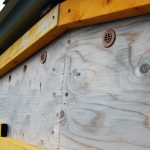DAMP-
A lot of things have happened since the latest article. During this time, I’ve felt a need to back-up some and discuss some basic problems that static caravans are plagued with. One of these is poor ventilation that leads to damp and an uncomfortable environment. Too, a damp atmosphere is not healthy in the long run nor does it argue for sustainable living.
I talked with a nearby neighbor about his static caravan and his comfort. He has a dehumidifier running and empties some 2 lt. or more of water most every day. What does his electricity costs look like? I spoke with another owner, with a relatively new static, and the dehumidifier is used “often”. I happened to stumble over a video where the presenter was explaining how to winterize a static caravan and most every point made was due to damp. Obviously, this is a problem and an expected belief about statics. As well, it can point a finger towards manufacturers more interested in sales results than consumer’s comfort.
Near the beginning of the project, I opened up an interior wall to see what the backside of the aluminum skin looks like, the part no one sees. I was met by a sight that confirms my suspicions of how wet a static caravan can be. The following picture is what I saw and it would hardly ever dry-out without good ventilation…(see gallery)
Having closed my static up and leaving it for 4 wintry months on Shetland, I came back and discovered something fantastic. My salt was dry! My other spices were dry! Everything from detergent to forgotten digestives were…dry!
The reason is simple but still complicated. With a regular static caravan, manufacturers make it look like air is being exchanged throughout the interior but the air is actually trapped due to manufacturers’, as I feel, fear of leakages.
Air in a normal static caravan rotates around. Without new air, it becomes damp through condensation.[/caption] Naturally, when static warm air connects with static cooler air, there is condensation. If there is too little flowing air, the humidity increases, causing an unfavorable living environment. It’s damp!
All dwellings must breathe, both inside and outside!
With this in mind and as I was renovating my static, I always had the above rule in mind. The day I took off the aluminum roof was the day I felt a drier air inside. I broke the seal and to this day I have no damp, closed in, old smells. How did I do it?
I built the outside walls in a fashion that a small air pocket ran up along between the insulation and the outside cladding. This air pocket connected to the loft area of the saddle roof. On the gable ends, I covered and weatherproofed the ends of the roof, but drilled air holes in the plywood, farthest up near the roofing, and covered these with a vertical wooden cladding. All this allows for the exchange of warm/cold air between the outside cladding, up into the loft and out/in through the holes I made.
Inside, I have an extractor fan that controls the airflow outwards every time I make food. This is over dimensioned and circulates a maximum of some 300 cubic meters of air p. hr. In the floor, where rain and water can’t get to, I have a small ventilation hole under the kitchen cabinets. All this, and each time I open the door or window, brings in fresh air from outside. When I leave, I make sure the ventilation is open. Note here, rain cannot go uphill and can never get under the exterior flooring outside.
Building in a correct and consequent way, cold air exchanged in the exterior air pockets is on the outside of the insulation area of the walls and ceiling. Heating is not any greater. I have approximately 65 cubic meters of air that needs heated. I have one oil-filled 2.0 kw heater. I have a gas cooker and an electric hot water heater. During the winter season, I use about £42-47 a month for all electricity, keeping an indoor temperature of circa +20° with nighttime reduction. Summer months in Shetland, I use about £20-22 a month for all electricity.
If done right, static caravans are enticing alternatives, support sustainable living and can be comfortably economic to live in.
- Condensation runs like rain on the backside of the exterior aluminum covering on a static caravan. Will it dry?
- Air in a normal static caravan rotates around. Without new air, it becomes damp through condensation.
- Drawing showing how fresh air flows around and to the loft of a static caravan.
- It appears there is interior ventilation, but….
- …it was only a trick! Covered over with wall cladding, NO VENTILATION!
- Ventilation holes into the loft area from outside. Water can’t go uphill and into the loft.
- Vertical gable boards allow fresh air to enter the loft area of a static caravan. This lets it “breathe”.
- Ventilation intake hidden under new kitchen cabinets. Can be closed when needed.









